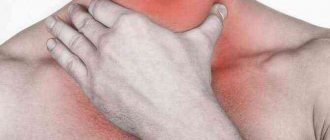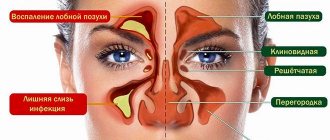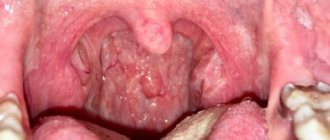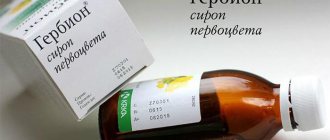Main symptoms
Correct determination of the cause based on the symptoms of the disease directly affects the effectiveness of therapy. If you focus on the wrong symptoms, you can aggravate the situation and provoke the development of complications. The following signs indicate the penetration of mucus into the throat area:
- Systematic soreness in the larynx, desire to cough.
- The presence of lumps of exudate in the sputum coming out.
- Difficulty swallowing with pain.
- Viscous saliva with mucus particles.
- Redness and irritation of the posterior wall of the nasopharynx.
If you have these symptoms for several days, you must make an appointment with a doctor. If you detect the accumulation of nasal discharge at an early stage, you will be able to cope with the disease without any problems. If the infection has penetrated deep into the larynx, the use of powerful antibacterial agents will be required.
In adults
Symptoms of the disease in adults are individual, and they include a number of additional points. Including:
- Trouble breathing through the nose. In this case, the probable cause may be a deviated septum.
- Bad breath. Staying inside the nasal cavity for a long time, the mucus acquires a specific pungent odor.
- Minor problems with the speech apparatus. The mucous sputum accumulated in the nasopharynx, due to its viscosity, interferes with free conversation.
In a baby
It is much more difficult to detect the presence of a problem in infants, since the symptoms of the disease are similar to the child’s usual behavior in other uncomfortable situations. In addition, for objective reasons, there are no direct complaints of a sore throat or pain in the nose.
The diagnosis of the disease in an infant should be carried out in cases where mucus flows from the nose, he often coughs and there is a suspicion of nasal congestion.
Other treatments
But what to do if drug treatment for a runny nose cannot be carried out constantly or is contraindicated for one reason or another? Is it possible not to use medications?
Cough and posterior rhinitis can be easily treated with folk remedies. Moreover, the sooner therapy is started, the better the result will be.
The most effective ways to help get rid of mucus in the throat and nose include:
- nasal rinsing;
- gargling;
- inhalation for a runny nose.
Rinsing the nose is useful if you need to deeply cleanse the nasal passages when the nasopharynx is clogged. At the same time, Dr. Komarovsky claims that this method prevents the development of complications by preventing bacteria from entering the bronchi.
The procedure is carried out using medications prepared independently or special solutions. So, for washing, you can buy medicines and a special kettle with a spout at the pharmacy. If the treatment will be carried out at home, you need to prepare a regular syringe and prepare a salt-based solution.
Signs of a cold should be treated in this way every day in the morning.
It is important to do this in the morning, since that is when the mucus flows most abundantly.
Gargling is no less effective than washing. To remove mucus from the throat you can use:
- Furacilin (1 tablet);
- manganese solution;
- soda solution.
It is best to rinse every day in the morning after rinsing the nasal cavity. Thanks to medicinal solutions, the pharynx will be cleared of pathogenic microflora, so after a few days from the start of treatment there will be a noticeable improvement.
Inhalation is another way to help eliminate cough and snot in the throat during the course of the disease, which is accompanied by these symptoms. But the procedure can be carried out if there is no temperature.
Inhalations should be done using herbal decoctions. Thus, chamomile relieves inflammation, eucalyptus facilitates the respiratory process and eliminates congestion, and sage has a drying and astringent effect.
Treatment of postnasal drip
Postnasal drip syndrome occurs due to certain problems in the ENT organs. Accordingly, treatment first of all consists in eliminating the main problem. Various methods can be used for this:
- antibiotic therapy – for bacterial diseases;
- Steroid therapy – treats allergic rhinitis
- decongestants in combination with antihistamines - for non-allergic rhinitis
- surgical correction – for deviated septum, chronic sinusitis, presence of Thornwaldt’s bursa
- elimination of problems of the digestive system - with reflux.
If treatment concerns children, then it is carried out using gentle methods, with careful medical supervision.
Important! Any medications are taken only as prescribed by a physician; self-medication can be ineffective and even dangerous!
As general ways to alleviate the condition of postnasal drip, treatment is complemented by:
- gargling with solutions of salt, furatsilin, decoctions of medicinal plants - sage, chamomile, oak bark, preferably in the morning;
- irrigation of the nasal cavity: warm water with salt at the rate of a teaspoon per liter is poured into a special device for irrigation;
- warming with steam - add essential oils to hot water - rosemary, eucalyptus, lavender, cover and inhale, use with caution, especially when treating children.
These measures will help treat idiopathic syndrome when the underlying cause of the problem is unclear.
There is treatment with folk remedies. Among them are used:
- a mixture of honey and aloe, a tablespoon after meals, will help eliminate cough;
- a mixture of honey and calendula petals - treatment for sore throat.
Postnasal drip syndrome can become chronic if not properly treated in a timely manner.
Prognosis and complications
Advanced postnasal drip can cause complications or become chronic.
Postnasal drip syndrome is a common phenomenon and if the provoking factors are eliminated, it goes away on its own. If the problem is left to chance, mucus will flow into the lower respiratory tract and can contribute to the development of diseases such as:
- Bronchitis
- Pneumonia
- Adenoiditis
As a result, an inflammatory process develops in the lower tract and can become chronic. Bacteria and other pathogenic microorganisms begin to actively multiply. Against this background, swelling of the bronchial branches occurs, the muscular system expands and sputum is released in large quantities.
Pneumonia affects the lung tissue. This is one of the dangerous and serious diseases characterized by fever, cough, shortness of breath, and sputum discharge.
It is important to begin treatment for postnasal drip in a timely manner to avoid serious consequences.
To prevent the occurrence of this unpleasant symptom, the following recommendations must be followed:
- Regularly humidify the air in the room and ventilate the room.
- Take measures to strengthen the immune system (harden yourself, lead a healthy lifestyle, spend more time in the fresh air, etc.)
- Treat respiratory infections in a timely manner and prevent them from becoming chronic.
- In case of defects in the nasal cavity, it is recommended to make a correction.
- Avoid inhaling strong odors, tobacco air, etc.
- During seasonal exacerbations, avoid contact with allergens if possible.
- Rejection of bad habits.
- Follow the principles of a balanced and proper diet, avoid eating fatty and fried foods.
These are the main preventive measures that must be followed in order to prevent the development of diseases of the ENT organs and the appearance of postnasal drip syndrome against their background.
Clinical manifestations
It is simply impossible not to notice postnasal drip syndrome in yourself, since it is accompanied by quite pronounced symptoms.
Moreover, the symptoms of the disease may vary depending on the position of the body. For example, if the patient lies down, the mucus drains, ending up on the epiglottis and vocal folds. The reflexogenic zones are irritated, causing a dry cough. And if the body is in an upright position, the symptoms appear less pronounced. So, the picture of the disease is as follows:
- There is an excessive accumulation of mucus in the throat area, which leads to discomfort in the patient. It is usually transparent or yellow in color. Sometimes clots of a jelly-like consistency appear.
- It is difficult to breathe, especially at night. Sometimes there is a lack of air, as in asthmatic syndrome.
- The nose is stuffy, but not always - mostly in the morning. Any vasoconstrictor drops help relieve congestion. As a result of constant “clogging”, local immunity is reduced, so a person becomes susceptible to colds.
- There is a feeling as if there is a lump in the throat. To get rid of it, the patient has to cough up.
- Itching and burning may occur in the nasopharynx as a result of excessive irritation of the mucous membrane.
- Less often, pain appears in the area of the maxillary sinuses, which indicates the spread of the inflammatory process. If the pharynx becomes involved, pharyngitis may develop.
- The mucus irritates the throat, causing pain in the throat area . This leads to difficulty eating food, as well as drinks that are too cold or hot.
- Mucus getting into the stomach can cause stomach upset. As a result, appetite decreases, pain appears in the area, and flatulence appears.
Typically, signs of postnasal drip appear in the morning. If the disease has become chronic, its manifestations also occur at night.
Home remedies for clearing sinuses
For clearing the sinuses, the best solution is Sodium Chloride solution, often referred to as sea water. Rinsing clears the nasopharynx of mucus, which constantly flows and can block the mouth of the paranasal sinuses. This speeds up the treatment of sinuses and alleviates persistent symptoms of rhinitis. This helps eliminate bacteria, dust and pollen, which relieves allergy symptoms.
Isotonic solution - 0.9% NaCl, is used to rinse the nose and cleanse the paranasal sinuses. It cleanses capillaries, reducing blood flow and swelling of the mucous membrane, has a moisturizing effect and relieves irritation. Solutions with a higher concentration stimulate the work of the cilia that cover the nasal mucosa. Thanks to this, the natural mechanisms responsible for cleansing the nose begin to work more efficiently. Cleansing the sinuses in children should be done with an isotonic solution; with it there is less risk of damage to the delicate mucous membrane.
Pharmacies have various preparations for rinsing the sinuses. Sea water is the safest and best way to cleanse the nose. You can use powders that are dissolved in boiled, cooled water, a ready-made preparation, or prepare the solution yourself.
Pharmacies sell sinus rinsing kits. This kit consists of an irrigator, the shape of which allows for thorough and safe cleansing of the sinuses, and bags of powder for preparing the solution. The sinus rinsing procedure should be performed 1-2 times a day.
Home remedies for mucus in throat
To cope with this condition, you can use available home remedies. For this purpose, furatsilin, chamomile or potassium permanganate are most often used. Each of these substances is excellent for rinsing the nose and gargling. All of them have pronounced antiseptic properties.
To prepare the remedy, potassium permanganate must be diluted with water to obtain a pale pink color. It is recommended to gargle 1-2 times a day. A contraindication to this procedure is a feeling of dry mouth.
You can also make a product based on furatsilin. To do this, a tablet of the drug must be mixed with 250 ml of warm water. This manipulation is performed three times a day. If rinsing does not help, you can try pouring this liquid through the nose. To do this, you can use a pipette or syringe. 1-2 ml of the product should be injected into each nasal passage.
An equally useful composition will be chamomile infusion.
- To make it, 1 dessert spoon of the flowers of this plant must be mixed with 200 ml of boiling water and left to infuse for half an hour.
- Apply the composition for rinsing several times a day.
To cope with the problem, you can use this recipe:
- Dissolve a small spoonful of soda and salt in a glass of warm water, then mix thoroughly.
- It is worth pouring literally a few drops of iodine into the resulting composition.
- You need to gargle with this mixture twice a day - morning and evening.
At night, it is recommended to drink warm milk with honey. You should also put 5 g of butter, a small spoon of sage and literally a pinch of soda into the drink. It is recommended to be treated in this way for a week.
Excellent results can be achieved by gargling with 3% hydrogen peroxide. If there is no allergy to this drug, it can be used in its pure form. It is quite possible to prepare a medicinal solution by mixing a large spoon of peroxide with 100 ml of water.
What to do if mucus from the nose flows into the child’s throat
It is possible to determine in a child that mucus flows into the throat only during sleep. The baby begins to grunt and cough. If these symptoms occur, the child should be taken to the doctor.
Therapy for postnasal drip in children is carried out in 2 directions: using sprays based on corticosteroids and antihistamines in combination with decongestants.
To get rid of viscous secretions, remove irritants, allergens and microbes, it is necessary to rinse with saline solutions. You can use soda, potassium permanganate. You can gargle with saline solutions (Aqua Maris, Aqualor, etc.). For the same purpose, you can use infusions of medicinal herbs: chamomile, calendula, eucalyptus.
Sprays based on glucocorticosteroids include Amavis, Nazolek, Flixonase, etc. The following drugs will help get rid of swelling of the nasal mucosa: Tavegil, Loratadine, etc.
Antibiotics are used only as prescribed by a doctor.
Depending on the age of the child, local antimicrobial drugs are used in small dosages. An alternative to antibiotic is Protargol. The drug is based on silver ions, which suppress the growth and reproduction of pathogens.
To eliminate unpleasant sensations in the throat, it is useful to lubricate with peach oil. During the treatment period, children and adults need to adhere to a diet and increase the consumption of foods with vitamins C and E.
Etiology
The nose is covered from the inside with a mucous membrane, which, when inflamed, swells, swells and becomes loose. Such processes are clinically manifested by nasal congestion and impaired nasal breathing. In the nasopharynx, exudate, which is a mucous secretion, begins to be actively produced. Some of it comes out in the form of snot. This is a natural process of cleansing the respiratory tract. The other part of the secretion flows down the back wall of the pharynx and accumulates in the throat. The patient is forced to constantly cough up and spit it out. This is how nasopharyngitis develops.
The process of mucus formation protects the body from penetration into deeper layers of microbes that enter the body from the outside. This viscous substance prevents the development of infectious pathologies of the bronchi and lungs. The mucous membrane of the nasopharynx produces a lot of secretions when the room is too hot. This is how it protects itself from dryness.
Rhinopharyngitis in itself is not a dangerous disease. It does not cause serious harm to health. But in the absence of timely treatment, chronicity of the process is inevitable. A chronic focus of infection in the body is a factor that suppresses the immune system and provokes the development of complications. Bacteria are carried through the bloodstream throughout the body, penetrating various organs, including the membranes of the brain.
Causes of mucus at the back of the throat
Bacterial infection
Quite often the cause of problems is a bacterial infection. The wall of the nasopharynx can be affected by staphylococci, streptococci and other pathogenic microorganisms. Dealing with them can be quite difficult. Therefore, it is worth preparing for long-term therapy.
Measles, rubella and scarlet fever
The appearance of a problem in a child may indicate the development of infectious pathologies. Diseases such as scarlet fever, measles or rubella often spread in kindergartens or primary schools. They are accompanied by pain and rashes. With scarlet fever, heavy discharge may also occur.
Polyps
Often mucus flows down the back wall of the nasopharynx due to the appearance of polyps in the nose. In such a situation, it will not be possible to do without surgical intervention, since medications will not help cope with the problem.
If the inflammatory process is left unattended, there is a risk of constant nasal congestion, coughing and sneezing. Also, the appearance of the disease may be accompanied by headaches, fever and other symptoms. As the disease progresses, the symptoms of inflammation intensify.
Adenoiditis
With inflammatory damage to the pharyngeal tonsil and its abnormal enlargement, people experience impaired nasal breathing and accumulation of pus. When adenoids grow, mucous secretions flow down the nasopharynx in 90% of cases.
Also, this anomaly often leads to hearing loss, the appearance of mucous discharge with purulent impurities and other manifestations.
Rhinitis
Even a common runny nose requires attention. With acute rhinitis, many people experience an accumulation of discharge. As the disease progresses, mucus begins to flow down the back wall. This process is usually characterized by cough and fever.
This condition leads to a general deterioration in health. Therefore, when you have a runny nose, you should use vasoconstrictors and anti-inflammatory medications.
Sinusitis
As rhinitis progresses, it can transform into sinusitis. Inflammatory damage to the paranasal sinuses leads to the accumulation of mucous secretions and the appearance of purulent impurities. As sinusitis develops, discharge may flow down the nasopharynx, which causes unpleasant symptoms.
Sinusitis should be treated under the supervision of a doctor. In order not to harm your health, you should not use medications on your own. If you violate the doctor's recommendations, there is a risk of exacerbation of sinusitis. In difficult situations, there is a need for surgical intervention.
Pharyngitis
When the mucous membrane is inflamed or the lymphoid tissue of the pharynx is damaged, a person is diagnosed with pharyngitis. This pathology is characterized by the synthesis of mucus, which often moves to the back surface of the nasopharynx.
People are usually diagnosed with a viral form of the disease. It becomes the result of infection with rhinoviruses, adenoviruses, and parainfluenza. Pharyngitis can also be a consequence of ARVI. In more rare cases, a bacterial form of the disease is observed.
Sinusitis
If a runny nose is not treated in time, there is a risk of serious consequences. In such a situation, an acute or chronic form of sinusitis appears. The pathology is always characterized by secretions flowing down the nasopharynx. This causes serious discomfort.
To cope with sinusitis, first of all you need to determine the localization of the pathology and determine the factors of its occurrence. The patient is then prescribed medication.
Other factors
Mucus at the back of the throat can indicate a variety of abnormalities. Often the reason lies in the development of allergies. In addition to the key symptoms, people complain of an itchy feeling in the ears. Weakness is often observed, the eyes become red and watery, and a sore throat appears. Many patients experience headaches.
Most often, this condition is observed with seasonal allergies - they appear at certain times of the year. Pollen from some trees can be an allergen. Sometimes allergens are objects with which a person constantly comes into contact. These include dust, wool, etc. In such a situation, manifestations of allergies occur constantly.
In addition, snot flows down the back of the throat when there is severe air pollution in the area where a person lives. Provoking factors can be exhaust fumes, cigarette smoke, intense odors of cosmetics. Eating too hot or cold food can also be a cause.
There are other factors that can cause similar problems. These include the following:
- pregnancy;
- changes in hormone balance;
- lack of timely treatment of rhinitis;
- frontal sinusitis, sinusitis, pharyngitis and other similar diseases - especially of a chronic nature;
- diseases of the otolaryngological organs;
- asthma;
- features of the anatomy of the nasopharynx - for example, the reason may lie in large nasal turbinates or a deviated septum.
In some situations, the volume of mucus increases with fluctuations in body temperature. This condition is especially relevant for a sharp decrease in this indicator. A provoking factor may be the use of certain foods or spices.
If the discharge has a very thick consistency, this indicates a fluid deficiency. Provoking factors for this condition are foreign objects in the nasal cavity, insufficient air humidity, and side effects of certain medications. Also, this symptom often appears in old age. This is due to a decrease in the thickness of the nasal mucosa.
In addition, normal clearing of secretions from the nasopharynx may be a consequence of problems with swallowing. These violations appear under the influence of such factors:
- stressful situations and emotional stress - this may cause a feeling of a lump in the throat;
- old age – in this case, the strength of swallowing decreases;
- narrowing of the throat - tumor formations and other anomalies can lead to it;
- stroke and various lesions of muscle tissue.
Causes of mucus in the throat











